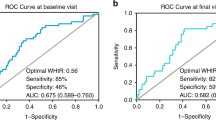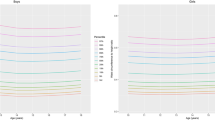Abstract
Objectives:
The optimal screening measures for obesity in children remain controversial. Our study aimed to determine the anthropometric measurement at age 10 years that most strongly predicts the incidence of cardio-metabolic risk factors at age 13 years.
Subjects/Methods:
This was a prospective cohort study of a population-based cohort of 438 children followed between age 7 and 13 years of age. The main exposure variables were adiposity at age 10 years determined from body mass index (BMI) Z-score, waist circumference (WC) Z-score, waist-to-hip ratio and waist-to-height ratio. Outcome measures included systolic (SBP) and diastolic blood pressure (DBP), fasting high-density (HDL-c) and low-density lipoprotein cholesterol (LDL-c), triglycerides, insulin and glucose (homeostasis model of assessment, HOMA), and the presence of metabolic syndrome (MetS).
Results:
WC Z-score at age 10 years was a stronger predictor of SBP (β 0.21, R2 0.38, P<0.001 vs β 0.30, R2 0.20, P<0.001) and HOMA (β 0.51, R2 0.25, P<0.001 vs 0.40, R2 0.19, P<0.001) at age 13 years compared with BMI Z-score. WC relative to height and hip was stronger predictors of cardio- metabolic risk than BMI Z-score or WC Z-score. The relative risk (RR) of incident MetS was greater for an elevated BMI Z-score than for an elevated WC (girls: RR 2.52, 95% confidence interval (CI): 1.46–4.34 vs RR 1.56, 95% CI 1.18–2.07) and (boys: RR 2.86, 95% CI 1.79–4.62 vs RR 2.09, 95% CI 1.59–2.77).
Conclusions:
WC was a better predictor of SBP and HOMA compared with BMI or WC expressed relative to height or hip circumference. BMI was associated with higher odds of MetS compared with WC. Thus, BMI and WC may each be clinically relevant markers of different cardio-metabolic risk factors, and important in informing obesity-related prevention and treatment strategies.
This is a preview of subscription content, access via your institution
Access options
Subscribe to this journal
Receive 12 print issues and online access
$259.00 per year
only $21.58 per issue
Buy this article
- Purchase on Springer Link
- Instant access to full article PDF
Prices may be subject to local taxes which are calculated during checkout
Similar content being viewed by others

References
Sarwar N, Gao P, Seshasai SR, Gobin R, Kaptoge S, Di Angelantonio E et al. Diabetes mellitus, fasting blood glucose concentration, and risk of vascular disease: a collaborative meta-analysis of 102 prospective studies. Lancet 2010; 375: 2215–2222.
Selassie M, Sinha AC . The epidemiology and aetiology of obesity: a global challenge. Best Pract Res Clin Anaesthesiol 2011; 25: 1–9.
Leiter LA, Fitchett DH, Gilbert RE, Gupta M, Mancini GB, McFarlane PA et al. Identification and management of cardiometabolic risk in Canada: a position paper by the cardiometabolic risk working group (executive summary). Can J Cardiol 2011; 27: 124–131.
Grundy SM . Pre-diabetes, metabolic syndrome, and cardiovascular risk. JACC 2012; 59: 635–643.
Prasad H, Ryan DA, Celzo MF, Stapleton D . Metabolic syndrome: definition and therapeutic implications. Postgrad Med 2012; 124: 21–30.
Biro FM, Wien M . Childhood obesity and adult morbidities. Am J Clin Nutr 2010; 91: 1499S–1505S.
Wen LM, Baur LA, Simpson JM, Rissel C, Wardle K, Flood VM . Effectiveness of home based early intervention on children's BMI at age 2: randomised controlled trial. BMJ 2012; 344: e3732.
Capizzi M, Leto G, Petrone A, Zampetti S, Papa RE, Osimani M et al. Wrist circumference is a clinical marker of insulin resistance in overweight and obese children and adolescents. Circulation 2011; 123: 1757–1762.
Tremblay MS . Major initiatives related to childhood obesity and physical inactivity in Canada: the year in review. Can J Public Health 2012; 103: 164–169.
Lau DC, Douketis JD, Morrison KM, Hramiak IM, Sharma AM, Ur E . 2006 Canadian clinical practice guidelines on the management and prevention of obesity in adults and children [summary]. CMAJ 2007; 176: S1–13.
Pemberton VL, McCrindle BW, Barkin S, Daniels SR, Barlow SE, Binns HJ et al. Report of the National Heart, Lung, and Blood Institute's Working Group on obesity and other cardiovascular risk factors in congenital heart disease. Circulation 2010; 121: 1153–1159.
August GP, Caprio S, Fennoy I, Freemark M, Kaufman FR, Lustig RH et al. Prevention and treatment of pediatric obesity: an endocrine society clinical practice guideline based on expert opinion. J Clin Endocrinol Metab 2008; 93: 4576–4599.
Logue J, Thompson L, Romanes F, Wilson DC, Thompson J, Sattar N . Management of obesity: summary of SIGN guideline. BMJ 2010; 340: c154.
Garnett SP, Baur LA, Srinivasan S, Lee JW, Cowell CT . Body mass index and waist circumference in midchildhood and adverse cardiovascular disease risk clustering in adolescence. Am J Clin Nutr 2007; 86: 549–555.
Janssen I, Katzmarzyk PT, Srinivasan SR, Chen W, Malina RM, Bouchard C et al. Combined influence of body mass index and waist circumference on coronary artery disease risk factors among children and adolescents. Pediatrics 2005; 115: 1623–1630.
Lawlor DA, Benfield L, Logue J, Tilling K, Howe LD, Fraser A et al. Association between general and central adiposity in childhood, and change in these, with cardiovascular risk factors in adolescence: prospective cohort study. BMJ 2010; 341: c6224.
Tybor DJ, Lichtenstein AH, Dallal GE, Daniels SR, Must A . Independent effects of age-related changes in waist circumference and BMI z scores in predicting cardiovascular disease risk factors in a prospective cohort of adolescent females. Am J Clin Nutr 2011; 93: 392–401.
Janssen I, Katzmarzyk PT, Ross R . Waist circumference and not body mass index explains obesity-related health risk. Am J Clin Nutr 2004; 79: 379–384.
Maffeis C, Pietrobelli A, Grezzani A, Provera S, Tato L . Waist circumference and cardiovascular risk factors in prepubertal children. Obes Res 2001; 9: 179–187.
Maffeis C, Banzato C, Talamini G . Waist-to-height ratio, a useful index to identify high metabolic risk in overweight children. J Pediatr 2008; 152: 207–213.
Lee S, Bacha F, Gungor N, Arslanian SA . Waist circumference is an independent predictor of insulin resistance in black and white youths. J Pediatr 2006; 148: 188–194.
Khoury M, Manlhiot C, Dobbin S, Gibson D, Chahal N, Wong H et al. Role of waist measures in characterizing the lipid and blood pressure assessment of adolescents classified by body mass index. Arch Pediatr Adolesc Med 2012; 166: 719–724.
Kozyrskyj AL, HayGlass KT, Sandford AJ, Pare PD, Chan-Yeung M, Becker AB . A novel study design to investigate the early-life origins of asthma in children (SAGE study). Allergy 2009; 64: 1185–1193.
Statistics USA: Third National Health and Nutrition Examination Survey (NHANES): Z-Score Reference for Height, Weight and BMI. http://www.cdc.gov/growthcharts Height; Accessed June 2012.
Cole TJ, Bellizzi MC, Flegal KM, Dietz WH . Establishing a standard definition for child overweight and obesity worldwide: international survey. BMJ 2000; 320: 1240–1243.
Katzmarzyk PT . Waist circumference percentiles for Canadian youth 11-18y of age. Eur J Clin Nutr 2004; 58: 1011–1015.
Jolliffe CJ, Janssen I . Development of age-specific adolescent metabolic syndrome criteria that are linked to the Adult Treatment Panel III and International Diabetes Federation criteria. JACC 2007; 49: 891–898.
Ginsberg HN . Insulin resistance and cardiovascular disease. J Clin Invest 2000; 106: 453–458.
Flodmark CE, Sveger T, Nilsson-Ehle P . Waist measurement correlates to a potentially atherogenic lipoprotein profile in obese 12-14-year-old children. Acta Paediatr 1994; 83: 941–945.
Savva SC, Tornaritis M, Savva ME, Kourides Y, Panagi A, Silikiotou N et al. Waist circumference and waist-to-height ratio are better predictors of cardiovascular disease risk factors in children than body mass index. Int J Obes Relat Metab Disord 2000; 24: 1453–1458.
Agatston A . Cardiology patient page. Why America is fatter and sicker than ever. Circulation 2012; 126: e3–e5.
Staiano AE, Katzmarzyk PT . Ethnic and sex differences in body fat and visceral and subcutaneous adiposity in children and adolescents. Int J Obes (2005) 2012; 36: 1261–1269.
Stockl D, Meisinger C, Peters A, Thorand B, Huth C, Heier M et al. Age at menarche and its association with the metabolic syndrome and its components: results from the KORA F4 study. PLoS ONE 2011; 6: e26076.
Acknowledgements
We would like to acknowledge the children and their families for their participation in the SAGE cohort study. We would also like to thank the Pediatric allergy and immunology research group specifically, Mrs Rishma Choonidas, Mr Saiful Huq, Mrs Brenda Gerwing and Mr Henry Huang who provided insight and guidance into data collection, storage and interpretation. Funding for the SAGE cohort was provided by CIHR and AllerGen NCE (PIs Becker and Kozyrskyj wave 1 data collection; Co-PI Becker wave 2 data collection).
Author information
Authors and Affiliations
Corresponding author
Ethics declarations
Competing interests
The authors declare no conflict of interest.
Rights and permissions
About this article
Cite this article
Wicklow, B., Becker, A., Chateau, D. et al. Comparison of anthropometric measurements in children to predict metabolic syndrome in adolescence: analysis of prospective cohort data. Int J Obes 39, 1070–1078 (2015). https://doi.org/10.1038/ijo.2015.55
Received:
Revised:
Accepted:
Published:
Issue Date:
DOI: https://doi.org/10.1038/ijo.2015.55
This article is cited by
-
Sociodemographic characteristics are associated with prevalence of high-risk waist circumference and high-risk waist-to-height ratio in U.S. adolescents
BMC Pediatrics (2021)
-
Predictors of Metabolic Complications in Obese Indian Children and Adolescents
The Indian Journal of Pediatrics (2021)
-
Association of breastfeeding duration, birth weight, and current weight status with the risk of elevated blood pressure in preschoolers
European Journal of Clinical Nutrition (2020)
-
Gender-specific mediators of the association between parental education and adiposity among adolescents: the HEIA study
Scientific Reports (2019)
-
Genetic contribution to waist-to-hip ratio in Mexican children and adolescents based on 12 loci validated in European adults
International Journal of Obesity (2019)


